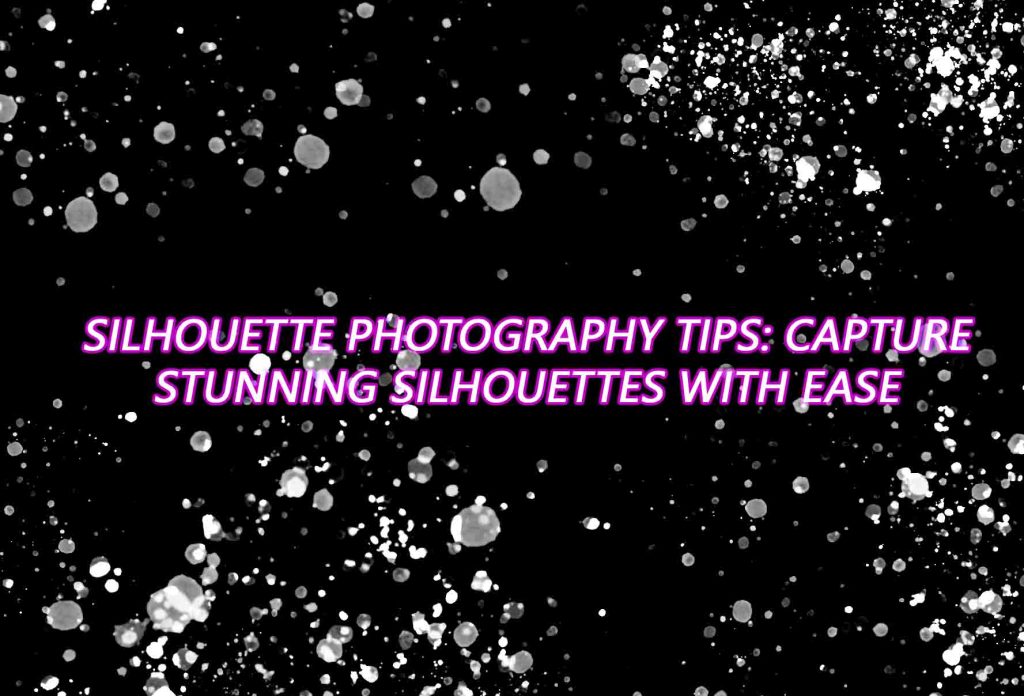Introduction:
Silhouette photography is a captivating and artistic genre that relies on the play of light and shadow to create powerful and evocative images. Whether capturing a striking sunset, a dynamic pose, or the distinctive outline of a subject against a vibrant background, silhouette photography offers a unique way to convey emotion and tell a compelling visual story. In this comprehensive guide, we’ll explore tips and techniques to help you master the art of silhouette photography and create stunning images with ease.
- Understanding the Basics of Silhouette Photography: Silhouette photography relies on strong contrast between the subject and the background. The subject is typically a dark, solid shape against a brighter background, creating a visually impactful image. To achieve this effect, it’s essential to position the subject between the camera and a strong light source, such as the sun, a streetlamp, or even a studio light.
- Choosing the Right Lighting Conditions: The quality and direction of light play a crucial role in silhouette photography. The most common and dramatic source of light for silhouettes is the sun, especially during the golden hours of sunrise or sunset. Position your subject so that the light is behind them, casting their form into a dark silhouette against the colorful sky. Experiment with the positioning of the light source to achieve different effects and moods.
- Selecting a Compelling Subject: While the technique is crucial, the subject of your silhouette can make or break the image. Choose subjects with distinct and recognizable shapes, such as people, trees, buildings, or animals. The outline should be easily distinguishable and convey a sense of drama or emotion. Experiment with various subjects to find what works best for your vision.
- Setting the Right Exposure: Achieving a well-defined silhouette requires proper exposure control. Since the subject is in shadow, the camera’s exposure settings should prioritize the background light. Use spot metering on the brighter background to expose for the highlights, ensuring that the subject remains dark. Consider using manual mode for better control over your exposure settings.
- Framing and Composition: Pay careful attention to the composition of your silhouette images. The simplicity of a silhouette is part of its beauty, so avoid cluttered backgrounds that can distract from the main subject. Experiment with different angles and compositions, such as capturing the silhouette against a vast sky or framing it within a natural element like trees or archways.
- Utilizing Natural Elements: Incorporating natural elements can enhance the visual impact of your silhouette photos. Experiment with reflections on water surfaces, which can add depth and interest to your composition. Coastal settings with crashing waves or serene lakes can provide dynamic backgrounds for your silhouettes.
- Creative Use of Shadows: Silhouettes are not limited to outdoor settings; you can also create captivating indoor silhouettes using artificial light sources. Experiment with placing your subject near a window or in front of a bright background to cast a distinct shadow on a wall. This technique can be particularly effective for portraiture.
- Choosing the Right Camera Gear: While you can capture compelling silhouettes with any camera, having the right gear can enhance your results. Use a camera with manual controls to have precise control over exposure settings. A lens with a wide aperture (low f-number) can help create a more pronounced silhouette by allowing less light to reach the camera sensor.
- Experimenting with Color and White Balance: Silhouette photography provides an excellent opportunity to play with color and white balance. The natural hues of sunrise and sunset can add warmth to your images, while shooting during the blue hour can create a cooler atmosphere. Adjusting the white balance can emphasize or neutralize the colors in your background, allowing you to create diverse and visually striking silhouettes.
- Post-Processing Techniques: While silhouette photography often relies on in-camera techniques, post-processing can be used to enhance and refine your images. Adjusting contrast, tweaking the levels, and fine-tuning the colors can help bring out the full potential of your silhouette photos. Experiment with different editing tools to achieve the desired mood and atmosphere.
- Creating Silhouettes in Urban Environments: Silhouette photography is not limited to natural settings; urban environments offer unique opportunities for capturing striking silhouettes against cityscapes. Utilize the architecture, neon lights, and the interplay between buildings to create compelling compositions. Look for interesting shapes and structures that can serve as captivating silhouettes.
- Adding a Human Element: Incorporating people into your silhouette compositions can add a sense of scale and narrative to your images. Experiment with different poses and gestures, encouraging your subjects to strike dynamic and expressive poses. Silhouetted figures against a dramatic sky can evoke powerful emotions and tell engaging stories.
- Understanding the Impact of Lens Flare: Lens flare, caused by direct sunlight hitting the camera lens, can either enhance or detract from your silhouette images. Experiment with the positioning of the light source to control the presence of lens flare. In some cases, a subtle flare can add a touch of atmosphere, while in others, it may be preferable to minimize its impact.
- Capturing Silhouettes in Motion: Explore the dynamic possibilities of capturing moving subjects as silhouettes. Whether it’s a person in mid-jump, a bird in flight, or waves crashing on the shore, freezing motion in silhouette form can result in visually compelling and energetic images. Use a fast shutter speed to capture the action crisply.
- Silhouette Photography in Low Light: While silhouettes are often associated with bright, natural light, you can experiment with capturing them in low-light conditions. Utilize artificial light sources creatively, such as street lamps or car headlights, to cast dramatic shadows and create captivating silhouettes in urban or nighttime settings.
Conclusion:
Silhouette photography is a versatile and expressive art form that allows photographers to convey emotion, drama, and storytelling through the interplay of light and shadow. By mastering the techniques outlined in this guide and experimenting with different subjects, environments, and lighting conditions, you can capture stunning silhouettes that resonate with viewers and showcase your unique creative vision. Remember to embrace experimentation, stay attuned to the nuances of light, and most importantly, let your creativity guide you as you embark on your journey into the captivating world of silhouette photography.
- What is Midjourney
 Discover the capabilities of Midjourney AI, learn how to effectively utilize the platform, and explore the advantages and disadvantages of the Midjourney AI image generator across its different pricing options.
Discover the capabilities of Midjourney AI, learn how to effectively utilize the platform, and explore the advantages and disadvantages of the Midjourney AI image generator across its different pricing options. - Brand identity elements
 In the vast marketing universe, imagery is pivotal in establishing and nurturing a brand’s identity. A brand’s visual choices are not merely aesthetic decisions but strategic moves that can significantly influence perception and performance. This Picfixs article explores the intricacies of selecting imagery that complements and enhances a brand’s essence, ensuring it resonates with the… Read more: Brand identity elements
In the vast marketing universe, imagery is pivotal in establishing and nurturing a brand’s identity. A brand’s visual choices are not merely aesthetic decisions but strategic moves that can significantly influence perception and performance. This Picfixs article explores the intricacies of selecting imagery that complements and enhances a brand’s essence, ensuring it resonates with the… Read more: Brand identity elements - 100 Best Mountain Captions and Mountain Quotes for Instagram
 Ready to scale new social media heights? Look no further than this treasure trove of 100 exhilarating captions and quotes, handpicked for your Instagram mountain posts!
Ready to scale new social media heights? Look no further than this treasure trove of 100 exhilarating captions and quotes, handpicked for your Instagram mountain posts! - Symmetry in Photography: A Creative Approach with Examples
 Delve into the enchanting realm of symmetry in photography as we showcase mesmerizing examples on our website. Experience the allure of perfectly mirrored images!
Delve into the enchanting realm of symmetry in photography as we showcase mesmerizing examples on our website. Experience the allure of perfectly mirrored images! - 11 Quarantine Photoshoot Ideas to Try at Home for Amazing Photos
 Looking for unique photoshoot ideas during quarantine? Explore the 11 creative suggestions that will help you capture unforgettable moments at home.
Looking for unique photoshoot ideas during quarantine? Explore the 11 creative suggestions that will help you capture unforgettable moments at home.


